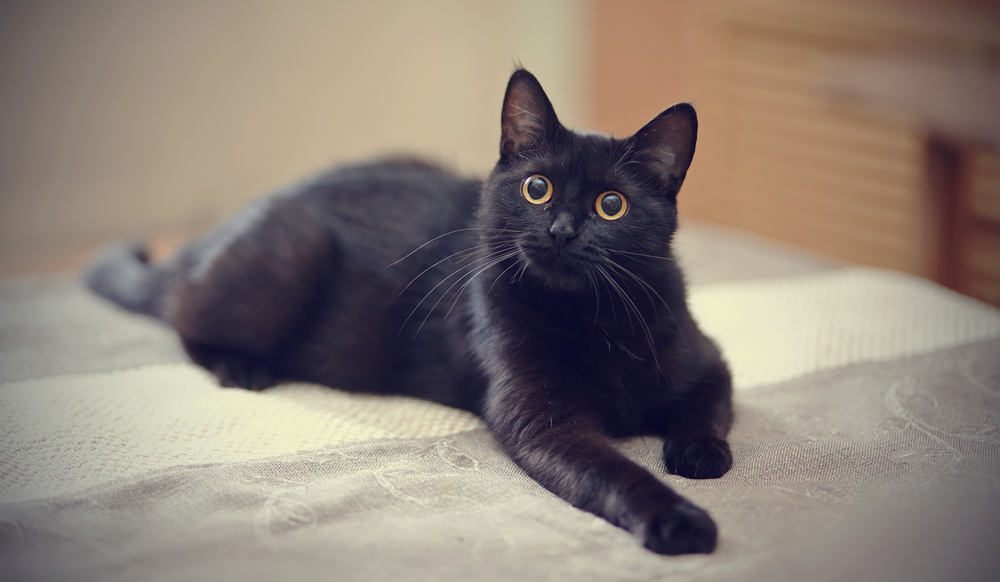The Symbolism Behind What a Black Cat Means: Are They Really Bad Luck?
Posted on Categories Discover Magazine

Cats pop up in folklore and history all the way back to the Egyptians — who were notorious cat lovers and even cat worshippers. Cats were adored in ancient Rome, China, and the Middle East as well.
However, cats were not adored so much in the European middle ages — especially black cats. In 1233, Pope Gregory IX issued a papal bull — Vox in Rama — as an injunction against (as well as a screed about) satanic cults that he’d been informed were proliferating in parts of Germany.
The Origins of Black Cat Superstition
The origins of black cat superstitions can be traced back to various historical, cultural, and religious beliefs. In the document’s colorful (and disgusting) descriptions of these heretical practices, Pope Gregory claimed that devil worshippers were consorting with their master in the form of a creature that was half man, half black cat.
Among other bizarre activities, participants in the ritual kissed the “cat’s rear,” according to a description by medievalist Irina Metzler in the scholarly paper, “Heretical Cats: Animal Symbolism in Religious Discourse.”
The pope disliked other animals, too. He disliked frogs and toads, but they never caught on as Halloween symbols. And the idea that cats were evil, particularly black cats, had staying power. Most serious scholars dismiss the connection between black cats and the increased ravages of the plague, but it didn’t help their reputation.
Read more: 20 Things You Didn’t Know About … Cats
The Superstition of Black Cats and Witches
By the 15th century, witches had been added to the list of those who consorted with the devil by means of cats. In 1486, Pope Innocent VII announced that the cat was “the devil’s favorite animal and the idol of all witches.”
Why Black Cats Have A Reputation For Evil
Black cats have a reputation for evil because the stories of witches and cats at satanic rituals as well as witches turning into cats at night were common. The latter stories often featured a cat that was wounded; the next day a suspected witch would show similar wounds. Tales of this sort were so frequent you might call it a genre.
All of this may have led to a centuries-long association between cats and evil — and thus the charming arch-backed cat silhouettes that today spruce up our secular decorations around Halloween.
Read More: Can Cats Dream? What Do Their Sleep Patterns Tell Us?
What Does a Black Cat Symbolize?
The symbolism of a black cat is a complex matter. In different cultures and throughout history, black cats have been associated with both good and bad omens. Here are some of the contrasting beliefs and associations with black cats.
Positive Black Cat Symbolism
In ancient Egypt, cats in general, including black ones, were highly revered and considered sacred. They were believed to bring good luck and protection.
Some considered a black cat on a ship as a lucky omen in some parts of England. If a black cat walked onto a ship and stayed, it was seen as a sign of good luck.
In Japan, black cats today are believed to bring prosperity, bless marriages, ensure good harvests, and even help bring success to theater productions.
Negative Black Cat Symbolism
In various Western cultures, including medieval Europe, black cats were associated with witches and considered to be witches’ familiars. They were often viewed as signs of bad luck and evil.
In 16th-century Italy, it was believed that if a sick person had a black cat lying on their bed, they would die. The fear of black cats was reinforced during the Middle Ages, particularly during outbreaks of the Bubonic Plague. Some believed black cats could spread disease, and they were often associated with the devil and witchcraft.
Read More: We’ve Relied On These 5 Animals Throughout History
Why Do We Think Cats Have Mystical Powers?
But why did cats grab and hold the imagination, and not, say, frogs? Metzler suggests the answer might lie in the fact that cats are not really all that domesticated. Having one foot in our world (sleeping peacefully by the hearth and chasing away rodents) and one foot somewhere else (who knows where cats go when they disappear for days at a time?) creates what Metzler calls a “conceptual tension.”
How Are Cats Useful?
Cats are useful because they hunt rodents. But it’s this very behavior that keeps them at least semi-wild. Metzler compares this to heretics, who are themselves not completely domesticated, she says, because they challenge orthodoxy and interpret religious belief however they like. Insisting on freedom and refusing to be constrained by rules. Sounds a lot like a cat, doesn’t it?
“As symbolic animals,” Metzler writes, “cats may be the heretical animal par excellence.”
Read more: Cats Ruled These 4 Ancient Civilizations
Are Black Cats Bad Luck or Good Luck?
Not every culture — even in Europe — thinks black cats are bad luck. Last May, Mark Rees, a Welsh author who recently published a book of Welsh myth and legend, posted on Twitter this verse from Welsh folklore (attributing the translation to the Reverend Elias Owen):
A black cat, I’ve heard it said,
Can charm all ill away,
And keep the house wherein she dwells
From fever’s deadly sway.
Why Are Black Cats Unlucky?
Most modern black cats are considered bad luck. Both anecdotal reports and scientific studies have shown that black cats are adopted less often and euthanized more often than cats of other colors. So this Halloween, enjoy the decorations and the folklore, but if you see a black cat, be nice to it. And don’t try to kiss its butt.
Read more: 5 Cats Who Owned Famous Scientists
This article was originally published on Oct. 22, 2022 and has since been updated with information from the Discover staff.